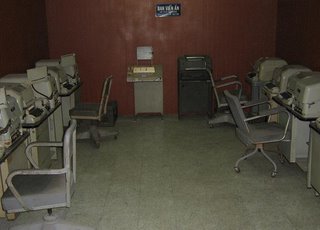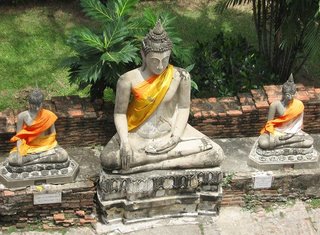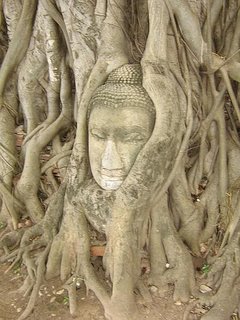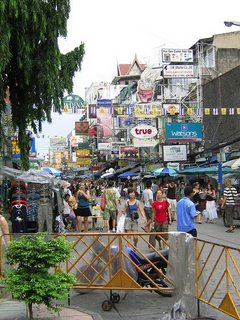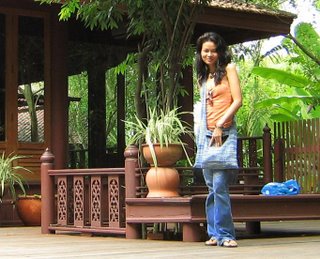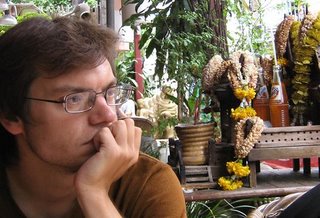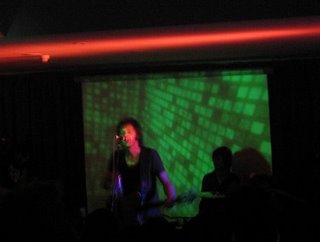 31st July 2006, Day 134
31st July 2006, Day 134Bondi, Sydney
'Oi, bruv, can I DI this bass?'
So we finally got around to checking out some gigs (the photo on the left is from the Lovejam event on Sunday). Boy, I was gig-thirsty! It didn't take us long to get drinking the three bottles of milky indie-rock goodness that were left on our doorstep.
King's Cross and it's vicinity have several venues, and I just hope St. Kilda (where we're odds on to end up in Melbourne) is just as good. I've heard a few things about the music scene being on the decline over the last few years there, mainly due to resident's complaints shutting down established venues.
Anyway, here's a little review of everything we've seen so far. Bear in mind that we haven't seen any live music in months so we might have a skewed view of what is good, especially after three months of being of subjected to James Blunt and the Red Hot Chilli Peppers in Thailand.
Thursday 27th July - Candy's Apartment, King's Cross
Dardanelles
Paper Scissors
My evening got off to a poor start when I was ID'd and had to march home to get my passport. I'm 26 now! This will still be happeneing when I'm 30. Fortunately home was only a 2 minute walk from the venue. After the Responsible Service of Alcohol course we undertook today, I now know that drinking culture and legislation is far tighter in Oz than at home. Candy's is cute little venue with tonnes of mirrorballs hanging from the ceiling and a young crowd. Paper Scissors are the sort of band I should have liked; they were subtle and pleasant enough, but me and James couldn't find a cutting edge with them, nor any memorable hooks. They sounded a bit like Modest Mouse. We were ready for something a bit more punchy, which arrived with Dardanelles. The singer was a well built young chap in a tight-sweater (the girls dug it), who bopped-around behind his microkorg to a technoed-up tunes backed by Bunnymen bass lines. Not a bad thing in my opinion, but of course there quite a few bands doing that at the moment like the Rapture or even the Bravery. After this we went on to a night in Paddington called 'Rock'n'Roll Motherf**ker', which I mentioned on my previous entry - this put a bit of a downer on the night.
Saturday 29th July - Spectrum, Darlinghurst
The Dolly Rocker Movement
Belles Will Ring
The Astral Kaleidoscope
This gig would have been mighty better/worse, if James and I hadn't drained a bottle of red wine before we set foot outside the flat. During a merry call to our good friend Rob Garmonsway (now affectionately termed the 'Buckinghamshire Bastard' by me and James) with whom we commiserated about Syd Barrett's death, we made our way through Darlinghurst to the Spectrum club the see some bands who offer Syd a bit of a debt.... even if that debt was mainly sartorial. A good-sized venue at the top of some stairs, full of hippy-ish clientelle, oil projectors and substantial bar meant that the red-plonk reservoir in my stomach was topped in time for The Astral Kaleidoscope. These guys were very much like early Velvet Underground, and despite all their songs being based around a template of thudding drones in 4/4, we enjoyed the groove they summoned up. James and I had plenty of red wines stains on our t-shirts even by the end of their set. In the Astral's wake, Belles Will Ring appeared. I'd refilled again my 120 ml standard measure of table wine by this point, but all I can remember is I thought this band were the best of the three. They had some good songs, managed to produce something out of the 60's trippy-kitsch-vibe and they had a gorgeous female keys player. With any luck, the band misinterpreted the rings in my eyes as being under the spell of the music rather than Australian grapes.
James and I didn't think the Dolly Rocker Movement were as much cop as the previous two bands, though our opinion by this point in the evening (I was tired and started dosing in the stair well while James was slumped near the front of the stage) is not to be trusted. The Dolly Rocker Movement were more song-based than the other groups from what I can remember and I felt Belles Will Ring had more tricks up their sleeve. We cut our losses and went home to bed.
Sunday 30th July - Lovejam @ Beach Road Hotel, Bondi
It was our good fortune to find out about this gig in time. Firstly it gave us an opportunity to get the hair of the dog as the events started at 2pm not long after we woke. Secondly it took us over to Bondi, a pretty suburb on a beautiful day, to see 40 plus live acts playing for FREE.
After hopping on a gratis bus to Bondi Junction in place of cancelled trains, we boarded another down to the beach. Bright sunshine beamed, warming the mild winter air to British summer temperatures (well, apart from this summer, 2003, 1990, 1989, 1976 etc.) We found our way over to a smashing venue where this bash was being held. The Beach Road hotel is like a really big, plush community centre, with massive rooms and pool tables. For the event all the big doors were open. A nice breeze was flowing from the public bar, past an acoustic act, through a restaurant and into the beer garden from where we listened to a feisty folk-group. We had a nice drink, letting our hang-overs lift with the spirit of the punters around us. We watched similar groups, until we got bored and decided to check out the rest of Bondi in the late afternoon.
 We went to a yard sale!! James bought a copy of a Nada Surf record for $2, which made him mightily pleased. A few streets further along near the beach, we encountered another sale overseen by some sarcastic students. James asked if they had any CD's for sale to which one haughty madam said we could listen to mp3's if we bought their knackered old PC. We were students once too, y'know! This is clearly a Sunday afternoon tradition in Bondi, it isn't just reserved for fictional American surburbia. James pointed at a sign along the lines of 'Garage sale: Furniture, Records and Shit', such is Aussie eloquence. Bondi is quite a posh district now, although I gather from almighty Wikipedia that this is a development of recent years. Indeed Bondi beach used to have sewage outlet pipe, which occasionally presented the surfers and swimmers with a 'Bondi Cigar'. I'll let you work out what that might be. The beach has also been cleaned up due to heavy investment.
We went to a yard sale!! James bought a copy of a Nada Surf record for $2, which made him mightily pleased. A few streets further along near the beach, we encountered another sale overseen by some sarcastic students. James asked if they had any CD's for sale to which one haughty madam said we could listen to mp3's if we bought their knackered old PC. We were students once too, y'know! This is clearly a Sunday afternoon tradition in Bondi, it isn't just reserved for fictional American surburbia. James pointed at a sign along the lines of 'Garage sale: Furniture, Records and Shit', such is Aussie eloquence. Bondi is quite a posh district now, although I gather from almighty Wikipedia that this is a development of recent years. Indeed Bondi beach used to have sewage outlet pipe, which occasionally presented the surfers and swimmers with a 'Bondi Cigar'. I'll let you work out what that might be. The beach has also been cleaned up due to heavy investment. A view of beautiful Bondi beach. Not nearly as tourist-tacky as some would have you believe. It is low season at the moment, so we have the chance to see it in it's best light. James is taking some nice pictures now; well done boss. We really want to get surfing as soon as possible after watching the waves roll in at Bondi because they seemed just the right height for us. We'll just have to wait until Melbourne, though.
A view of beautiful Bondi beach. Not nearly as tourist-tacky as some would have you believe. It is low season at the moment, so we have the chance to see it in it's best light. James is taking some nice pictures now; well done boss. We really want to get surfing as soon as possible after watching the waves roll in at Bondi because they seemed just the right height for us. We'll just have to wait until Melbourne, though. Later in the evening we headed back to the Lovejam, and James jumped on the vintage video game machine. He was rubbish at Donkey Kong, and I let him know that in lucid terms. The atmosphere was pretty energetic now, and it was time for full-on DJs and bands. We watched more acts, but after a while the venue got so stuffed to the gills, it took about three minutes to get up or down the stairs. Had I been in possession of today's knowledge, I could have invoked the legislation in the 1982 Liquor Act and had the place shut early for breaching capacity restrictions. Just as well because as a responsible citizen I would have been obliged to do just that.
Later in the evening we headed back to the Lovejam, and James jumped on the vintage video game machine. He was rubbish at Donkey Kong, and I let him know that in lucid terms. The atmosphere was pretty energetic now, and it was time for full-on DJs and bands. We watched more acts, but after a while the venue got so stuffed to the gills, it took about three minutes to get up or down the stairs. Had I been in possession of today's knowledge, I could have invoked the legislation in the 1982 Liquor Act and had the place shut early for breaching capacity restrictions. Just as well because as a responsible citizen I would have been obliged to do just that.Over the last few days we've already 'hatched' an idea for a band, called Chicken Satchel, and we are near acquiring the essential item for any band - a myspace page. You may think we are attempting to waddle before pecking out of our shell, but I suggest that modern bands should have a myspace page prior to their first rehearsal. It provides sustenance akin to eating that clacium-rich egg shell. The band will mainly just be Asker/Morton improvised vocal jazz screamed into a dictaphone. Mp3's are on their way to you soon!!
Not to be outdone by our antipodean antics, here are some interesting visual artefacts of our mates Zaf, Jerome, Caroline and Shehnoor's 'Noise Night' back in Blighty. I trust the ultimate goal was to be as avant-garde as possible, regardless of the personal cost. The photos are courtesy of Craig Sanderson. I have not asked Craig's permission to reproduce them and instead rely upon his dwindling reserves of good will.
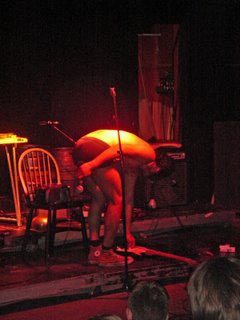 Zaf with a microphone and a nice old fashioned wooden chair. I don't know why he's in his underpants. Don't pick up that guitar...
Zaf with a microphone and a nice old fashioned wooden chair. I don't know why he's in his underpants. Don't pick up that guitar...
 ...aarrgghh. And less than a mile from my cosy suburban home. See, this is music with it's tongue in it's (arse) cheek. I am glad to be a friend to these people who are all now pushing thirty and have no interest in knowing any better. They are turning nothing Thursday nights in East Berkshire into legendary events for the benefit of humankind... I salute them!
...aarrgghh. And less than a mile from my cosy suburban home. See, this is music with it's tongue in it's (arse) cheek. I am glad to be a friend to these people who are all now pushing thirty and have no interest in knowing any better. They are turning nothing Thursday nights in East Berkshire into legendary events for the benefit of humankind... I salute them!
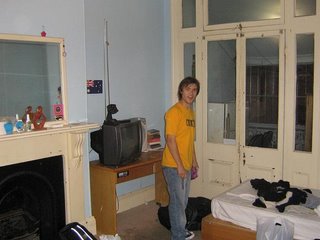
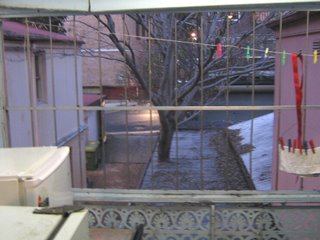 Our balcony. Our road runs parallel to Darlinghurst Road, which basically IS King's Cross.
Our balcony. Our road runs parallel to Darlinghurst Road, which basically IS King's Cross.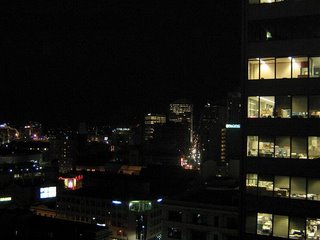
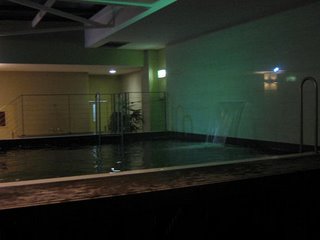

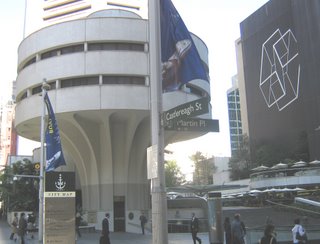

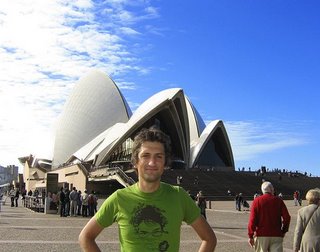
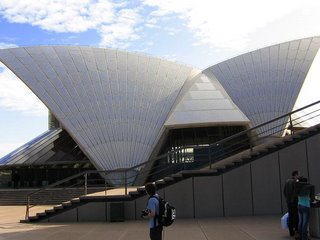



 So what is it like today? We've been in Ho Chi Minh City (HCMC) for three days now and I've packed in as much as possible including watching the World Cup final until 5 o'clock in the morning yesterday night. This is the first time I've visited a strictly non-western society, having spent time in Thailand (where there is something approaching a democracy, despite the present polictical deadlock) and Cambodia (where there is lip-service to it). As you will know, the Vietnamese version of perestroika means that at first glance there's little different in HCMC from the neighbouring cities on the Malay peninsula (bar those in Burma no doubt), but it is still, if only in name, Communist. There are hammer and sickle flags along all major streets, but despite the average wage being lower than Thailand, it is higher than Cambodia. Familiar shops, bars, laundries, but above all low-powered motorbikes fill the streets.
So what is it like today? We've been in Ho Chi Minh City (HCMC) for three days now and I've packed in as much as possible including watching the World Cup final until 5 o'clock in the morning yesterday night. This is the first time I've visited a strictly non-western society, having spent time in Thailand (where there is something approaching a democracy, despite the present polictical deadlock) and Cambodia (where there is lip-service to it). As you will know, the Vietnamese version of perestroika means that at first glance there's little different in HCMC from the neighbouring cities on the Malay peninsula (bar those in Burma no doubt), but it is still, if only in name, Communist. There are hammer and sickle flags along all major streets, but despite the average wage being lower than Thailand, it is higher than Cambodia. Familiar shops, bars, laundries, but above all low-powered motorbikes fill the streets.

